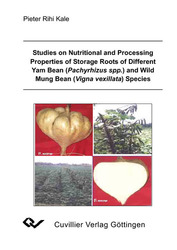| Departments | |
|---|---|
| Book Series (96) |
1378
|
| Nachhaltigkeit |
3
|
| Gesundheitswesen |
1
|
| Humanities |
2363
|
| Natural Sciences |
5406
|
| Mathematics | 229 |
| Informatics | 319 |
| Physics | 980 |
| Chemistry | 1363 |
| Geosciences | 131 |
| Human medicine | 243 |
| Stomatology | 10 |
| Veterinary medicine | 108 |
| Pharmacy | 147 |
| Biology | 835 |
| Biochemistry, molecular biology, gene technology | 121 |
| Biophysics | 25 |
| Domestic and nutritional science | 45 |
| Agricultural science | 1004 |
| Forest science | 201 |
| Horticultural science | 20 |
| Environmental research, ecology and landscape conservation | 148 |
| Engineering |
1791
|
| Common |
97
|
|
Leitlinien Unfallchirurgie
5. Auflage bestellen |
|
Advanced Search
Studies on Nutritional and Processing Properties of Storage Roots of Different Yam Bean (Pachyrhizus spp.) and Wild Mung Bean (Vigna vexillata) Species (English shop)
Pieter Rihi Kale (Author)Preview
Table of Contents, Datei (46 KB)
Extract, Datei (90 KB)
The present study is the first evaluation of chemical composition of storage roots of yam bean (Pachyrhizus spp.) and wild mung bean (Vigna vexillata) of a large number of samples from many Indonesian islands (Indonesian germplasm). In spite of the fact that yam bean and wild mung bean storage roots have been used for several different purposes in food and non-food application, there are not many studies on the storage roots chemical compositions. The storage roots quality information is important not only for food and nonfood processing but also for breeding program. Through this study, such information becomes available. Not to mention many other advantages, yam bean (Pachyrhizus spp.) is a promising plant for the future in respect to its high fresh storage roots yield production (with low-maintenance) and some nutritional elements such as protein, starch, dietary fiber and Fe, which are higher than conventional storage roots crops. The only downside of this plant is that the storage root fresh weight consists of more than 80% water. However, yam bean P. tuberosus species with high dry matter content break the barrier to lowering the water content of the species through suitable breeding program. Yam bean storage roots contain higher total protein content (almost double) compared to that of most other traditional storage roots crops and therefore it may have significant contribution to the nutritional quality of the storage roots. A protein rich storage root seems to be a specific characteristic of many genotypes, which is interesting and important for plant breeder when using them as genetic resources. The main composition of the dry matter is the starch which characterized by having very low amylase content suitable as alternative for waxy starch in food application. This characteristic makes the materials suitable for all-purpose thickeners in food. The storage roots of yam bean P.erosus species are characterized by higher sugar content that make them sweeter than the other two species (P. tuberosus and P.ahipa). Yam bean storage roots are also characterized as an important sources of dietary fiber and minerals especially Fe.
| ISBN-13 (Printausgabe) | 3865377866 |
| ISBN-13 (Hard Copy) | 9783865377869 |
| ISBN-13 (eBook) | 9783736917866 |
| Language | English |
| Page Number | 132 |
| Edition | 1 |
| Volume | 0 |
| Publication Place | Göttingen |
| Place of Dissertation | Göttingen |
| Publication Date | 2006-03-01 |
| General Categorization | Dissertation |
| Departments |
Agricultural science
|








